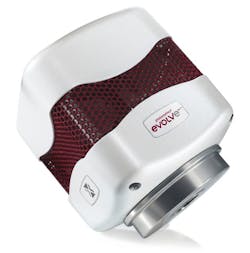The Evolve 128 EMCCD camera from Photometrics (Tucson, AZ) features QuantView, which provides repeatable methodology to gather and interpret live imaging data by reading out pixel values in photoelectrons, and Background Event Reduction. The camera suits techniques such as in-vivo imaging and cell physiology, as well as spinning disk confocal microscopy and single molecule fluorescence (SMF). Its eXcelon sensor technology increases broadband quantum efficiency in blue wavelengths while reducing etaloning in near-infrared wavelengths.
-----
PRESS RELEASE
Photometrics® Announces Exclusive eXcelon™ Technology Integration for Evolve™ 512 and 128 EMCCD Cameras
November 1, 2010
eXcelon provides world’s best broadband sensitivity for in vivo imaging and multiplexed fluorescent dye experiments
Tucson, AZ — Photometrics, a designer and manufacturer of high-performance CCD and EMCCD cameras for the life sciences, has exclusively integrated eXcelon sensor technology in its Evolve 512 and 128 EMCCD cameras. eXcelon, a breakthrough back-illuminated CCD and EMCCD detector technology, was jointly developed by Photometrics, Princeton Instruments and e2v Technologies to tackle specific issues associated with bio-research applications. eXcelon sensors image blue and near-infrared (NIR) wavelengths with higher quantum efficiency. The technology also significantly reduces etaloning, a fringe pattern noise common to imaging NIR wavelengths.
The eXcelon sensors possess high sensitivity across the NIR, which is crucial for whole animal and other in vivo imaging studies because tissue auto-fluorescence at these wavelengths is lowest. NIR fluorescent probes, unlike visible-light probes, afford more transparent views through intermediate tissue. eXcelon’s broadband sensitivity also enables development of such novel fluorescent probes.
“The majority of fluorescent probes for in vivo imaging are confined to light wavelengths that humans can see and what current CCD technologies can easily and quantitatively detect,” said Deepak Sharma, Ph.D., director of product management and marketing at Photometrics. “High sensitivity in the blue and near infrared spectrum of Evolve EMCCD cameras with eXcelon sensors enables development and the use of probes fluorescing at newly accessible wavelengths. Researchers can use these probes to multiplex imaging experiments and obtain much richer data for correlative studies.”
“Photometrics and Princeton Instruments are proud to be the exclusive suppliers of cameras offering this enhanced capability. Using Evolve EMCCD cameras with eXcelon sensors, researchers can expect up to six times less etaloning at the same dark noise levels.” said Ravi Guntupalli, product manager at Princeton Instruments.
eXcelon is an example of a unique joint development between three technological leaders which enables new scientific endeavors allowing insight into previously unattainable but much sought after and valuable knowledge.
